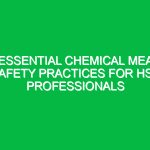Introduction
The term “confined space” holds significant importance within the Health, Safety, and Environment (HSE) domain. It refers to any space that is not designed for continuous human occupancy, which can pose unique hazards to workers. Understanding the confined space meaning is crucial for ensuring safety and compliance during operations in industries such as construction, manufacturing, and wastewater treatment. This article will explore the key aspects of confined space meaning, relevant safety measures, and regulatory standards, providing insights that are essential for both employers and employees involved in confined space work.
Defining Confined Space Meaning
To grasp the full significance of confined space meaning, we must first define what constitutes a confined space. Typically, a confined space is characterized by the following criteria:
- It is large enough for a person to enter and perform work.
- It has limited means of entry or exit.
- It is not designed for continuous occupancy.
These spaces might include tanks, silos, vaults, pits, or pipelines. The limitations on entry and exit can result in hazardous situations, such as the buildup of toxic gases, low oxygen levels, or the risk of engulfment. For instance, in a manufacturing facility, workers might be required to enter a storage tank to conduct maintenance or inspections. If proper precautions are not taken, the confined space can quickly become a dangerous environment.
Key Hazards in Confined Spaces
Understanding the hazards associated with confined spaces is vital for ensuring worker safety. Some common hazards include:
- Atmospheric Hazards: These include oxygen deficiency, flammable gases, and toxic substances. For example, in a sewage treatment plant, hydrogen sulfide gas can accumulate, posing a severe risk to anyone entering the space.
- Physical Hazards: These may involve machinery, moving parts, or the potential for slips, trips, and falls. In a confined space with limited visibility, a worker could easily trip over equipment or lose their footing.
- Engulfment Hazards: This occurs when a worker is surrounded by material such as liquids or loose solids, which can lead to drowning or suffocation. In grain silos, for instance, workers may be engulfed by flowing grain if proper precautions are not in place.
Recognizing these hazards is the first step towards establishing a safe work environment within confined spaces.
Best Practices for Confined Space Safety
Implementing best practices for confined space safety is essential for minimizing risks. Here are some key strategies:
1. Conduct Thorough Risk Assessments
Before entering a confined space, employers should conduct comprehensive risk assessments to identify potential hazards. This process involves evaluating the environment, the nature of the work, and any associated risks. For example, a construction site supervisor might assess a confined space for the presence of hazardous fumes or inadequate ventilation before allowing workers to enter.
2. Develop and Implement Safety Procedures
Establishing clear safety procedures is vital for ensuring that all personnel understand the protocols for entering confined spaces. This should include step-by-step guidelines for preparing the space, conducting work, and exiting safely. For instance, a procedure might dictate the use of air monitoring equipment to check for oxygen levels before any work begins.
3. Provide Proper Training
Training workers on confined space safety is essential. This includes educating them about the specific hazards they may encounter, proper use of personal protective equipment (PPE), and emergency response procedures. A company might hold regular training sessions to keep workers informed about the latest safety practices and technologies.
4. Use Appropriate Equipment
Utilizing the right equipment can significantly enhance safety in confined spaces. This includes using gas detectors, ventilation systems, and harnesses with retrieval lines. For example, portable gas monitors can alert workers to dangerous atmospheric conditions, allowing for timely evacuation if needed.
5. Establish a Permit System
A confined space entry permit system is an effective way to control access to hazardous areas. This system requires that certain conditions are met before entry is allowed, including atmospheric testing and ensuring that rescue personnel are on standby. For instance, at a chemical plant, supervisors might issue permits that outline specific safety checks that must be completed before workers can enter a confined space.
Real-Life Examples and Case Studies
To illustrate the importance of understanding confined space meaning, consider the following real-life example:
In 2010, a tragic incident occurred at a wastewater treatment facility where two workers lost their lives after entering a confined space without adequate safety measures. The investigation revealed that the atmosphere contained toxic gases, and the workers were not equipped with proper monitoring devices. This incident underscores the critical need for rigorous adherence to confined space safety protocols.
On a more positive note, a manufacturing company implemented a robust confined space safety program that included regular training and a strict permit system. As a result, they reported a reduction in incidents related to confined space entries over a two-year period. This example demonstrates how effective safety measures can lead to improved outcomes and protect workers from harm.
Regulations and Standards Governing Confined Spaces
Numerous regulations govern confined space operations, emphasizing the importance of safety in these environments. In the United States, the Occupational Safety and Health Administration (OSHA) has established standards specifically for confined spaces under 29 CFR 1910.146. This standard outlines the responsibilities of employers, including the need for proper training, hazard assessment, and the provision of rescue services.
Similarly, the National Fire Protection Association (NFPA) and the American National Standards Institute (ANSI) provide guidelines and recommendations for safe practices in confined spaces. These regulations not only protect workers but also help organizations avoid costly fines and legal repercussions.
Conclusion
Understanding confined space meaning is essential for ensuring the safety and well-being of workers in hazardous environments. By recognizing the unique risks associated with confined spaces and implementing robust safety practices, organizations can significantly reduce the likelihood of accidents and injuries. The importance of training, risk assessments, and adherence to regulations cannot be overstated in fostering a culture of safety within the workplace.
As we move forward, it is imperative for companies and workers alike to remain vigilant and proactive in their approach to confined space safety. By doing so, we can unlock not only the meaning of confined spaces but also a profound commitment to protecting human life and the environment.


